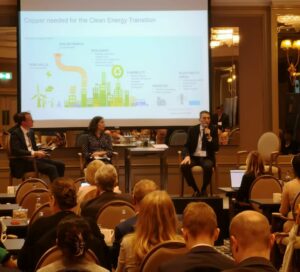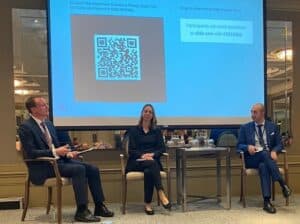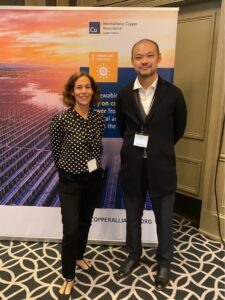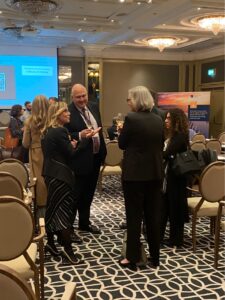Reflections from the Concordia Annual Summit
Energy efficiency is key to delivering more than 40 percent of the Paris Agreement goals. Enabling efficient technologies and energy transfer reduces energy waste, makes the power grid more resilient, decreases carbon emissions and reduces cost to consumers.
At the Concordia Annual Summit, the International Copper Association (ICA) held a closed roundtable with U.S. leaders from across business, academia, NGOs and IGOs to address this gap. Participants included Presidents and CEOs from Siemens USA, Holsman International, Veracity Worldwide and the Business Council for Sustainable Energy. ICA was also joined by representatives from the University of Virginia Darden School of Business, Signify, the Chiricahua Health Foundation and Lewis-Burke Associates LLC. Together, these experts identified challenges facing the shift to energy-efficient infrastructure and appliances and discussed potential solutions and ongoing initiatives to help fill the energy-efficiency gap.
Raising Awareness to Ensure a Just Transition
Unlike most other types of waste, energy waste is intangible—its effect often only felt through rising energy costs. Energy waste increases greenhouse gas (GHG) emissions and decreases the resiliency of the power grid. The increased energy demand resulting from inefficient energy use places a greater load on energy-related infrastructure—straining resources, increasing the likelihood of outages and decreasing the grid’s ability to meet demand. Increased energy requirements from energy waste also make governments, businesses and consumers more reliant on global energy supply chains and geopolitical instabilities.
Despite these multitudes of effects resulting from inefficient power usage, the lack of awareness and tangibility of these issues presents a major barrier to solution implementation. While renewable energy generation and the clean energy transition are widely discussed in policy and wider society, the discussion on how to maximize the clean energy power supply has not reached the mainstream.
Energy efficiency’s impact goes beyond emissions; it ensures a just transition. Areas with higher levels of socio-economic development and education, have typically increased levels of implementation of energy-efficient technologies and infrastructure. Populations where energy efficiency could create a greater impact financially and environmentally usually have inefficient infrastructure. Energy efficiency requires scale of implementation to ensure an inclusive transition and meet the goals of the Paris Agreement.
Shifting Risk and Reward
Multiple actors play a role in scaling energy-efficiency solutions. Although they face unique stakeholder challenges, energy service companies (ESCO), commercial entities and governments can be part of the solution.
Energy Service Companies (ESCO)
- Opportunity: ESCOs can retrofit existing technologies with energy-efficient motors, HVAC systems, refrigeration units or LED lighting systems, for example. This benefits both the ESCO and the end user, as energy-efficient technologies are often safer, more reliable and resilient. This is due to the use of reliable and conductive materials, such as copper, that can handle high levels of heat and electricity.
- Challenge: For ESCO companies to provide energy-efficient services and technologies at affordable prices, market demand must exist at scale.
Commercial Entities
- Opportunity: Energy-efficient applications and infrastructure investments, such as commercial building upgrades or industrial motors, can have a lifespan of 40 years, making the investment more cost efficient over the lifecycle of the application. The benefits of implementing energy-efficient technologies will have an equally long-lasting effect.
- Challenge: Commercial companies operate on shorter investment time horizons, which often make justifying longer-term financial investments, such as replacing equipment or infrastructure with more energy-efficient alternatives, more difficult than financing immediate needs. For commercial enterprises, there is a continuous pull between economic competitiveness and energy usage.
Governments
- Opportunity: Governments are often one of the largest land and property owners, which means action on energy efficiency in governmental infrastructure can produce a significant impact.
- Challenge: Governments must justify expenditures to constituents and must follow budget appropriations. Governmental oversight mechanisms require data collection and multi-level approvals, which can make implementation slower than private sector actors.
Increasing Accountability for Energy-Efficiency Targets
Part of addressing the challenges facing government and industry is increasing transparency and accountability mechanisms to enable action on energy efficiency.
Performance Metrics
- Ensure energy-efficiency performance metrics are included in public and private energy performance and sustainability reports.
- Include energy efficiency metrics in green funding initiatives.
Stakeholder Accountability
- Identify individuals or teams with the technical knowledge and accountability for overseeing progress toward energy-efficiency metrics.
- Increase awareness of the benefits of energy-efficient solutions at the governance or board level to raise the importance of the targets within a company or government program’s operations.
Nationally Determined Contributions (NDC)
- Include formalized energy-efficiency targets and minimum energy performance standards (MEPS) in Nationally Determined Contributions (NDC). These are government commitments toward reducing national emissions that are required by the Paris Agreement to ensure global accountability of countries in their climate mitigation efforts.
Developing Solutions
To enable energy efficiency at scale, stakeholders must develop a framework that incentivizes and facilitates this transition. The possibilities include:
- Create profit sharing models between government landowners and private contractors to lessen upfront costs for both parties.
- Capitalize on the resources and brain power of universities to bring public and private actors together to raise awareness of energy-efficiency solutions among the financial community and practitioners.
- Develop “energy-efficiency hubs” that function similarly to energy-oriented hubs, such as those for green hydrogen.
- Connect infrastructure and energy policies to education and skill development to ensure the next generation is equipped to maintain, develop and implement energy-efficient solutions. With half of the world’s population younger than 30 years old, educating and preparing youth to meet these challenges will aid their ability to act.
- Establish educational guidance and best practices for cities, companies and consumers on implementing and funding energy-efficient solutions will also help small and medium enterprises take action. Progress must occur from the local to the international level.








